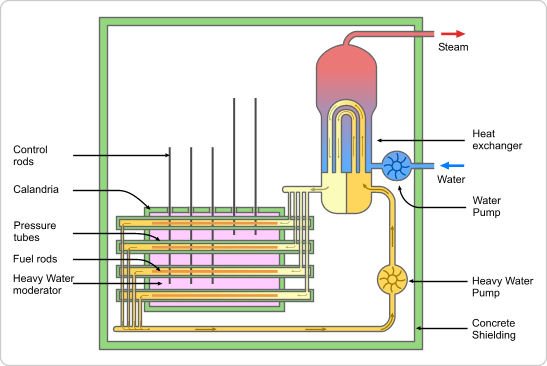India’s first indigenously developed 700 MW nuclear power reactor at the Kakrapar Atomic Power Project (KAPP) in Gujarat commenced commercial operations on Friday, June 30. The KAPP-3 reactor is currently functioning at 90 percent of its total power capacity. This achievement marks a significant milestone in India’s nuclear power sector, as it demonstrates the country’s capability to develop and operate advanced nuclear reactors. The successful operation of the Kakrapar reactor contributes to India’s efforts in meeting its energy needs through clean and sustainable sources.
More About the News
- The Nuclear Power Corporation of India Limited (NPCIL) is currently constructing two 700 MW pressurized heavy water reactors (PHWRs) at the Kakrapar Atomic Power Project (KAPP) in Gujarat, where two 220 MW power plants are also located.
- As of May end, various commissioning activities were in progress at KAPP 4, which has achieved 96.92 percent progress, according to officials.
- NPCIL has plans to build a total of sixteen 700 MW PHWRs across different locations in India, and the necessary financial and administrative approvals have been granted.
- Construction work is underway for 700 MW nuclear power plants at Rawatbhata in Rajasthan (RAPS 7 and 8) and Gorakhpur in Haryana (GHAVP 1 and 2).
Additionally, the government has given approval for the construction of 10 indigenously developed PHWRs in fleet mode at four different locations – Gorakhpur in Haryana, Chutka in Madhya Pradesh, Mahi Banswara in Rajasthan, and Kaiga in Karnataka.
What is Nuclear Energy?
Nuclear energy is the energy released when atoms are split apart. This process is called nuclear fission. Nuclear energy is used to generate electricity in nuclear power plants.
- The fuel used in nuclear power plants is uranium. Uranium is a naturally occurring element that is found in rocks all over the world.
- The process of nuclear fission is used to generate heat in a nuclear power plant. The heat is used to boil water, which turns into steam and drives a turbine to generate electricity.
- Nuclear power plants are very safe. There have been only a few accidents in the history of nuclear power, and these accidents have been relatively small.
- The waste produced by nuclear power plants is radioactive. This means that it is harmful to human health. However, the waste can be disposed of safely in deep underground repositories.
Advantages of Nuclear Energy
- It is a low-carbon source of energy. Nuclear power plants do not produce greenhouse gases, which contribute to climate change.
- It is a reliable source of energy. Nuclear power plants can operate 24 hours a day, 7 days a week, regardless of the weather.
- It is a secure source of energy. Nuclear power plants are not vulnerable to terrorist attacks or natural disasters.
Disadvantages of Nuclear Energy
- The cost of building and operating nuclear power plants is high.
- There is the risk of accidents, such as the Chernobyl disaster in 1986.
- The waste produced by nuclear power plants is radioactive and must be disposed of safely.
Overall, nuclear energy is a controversial source of energy. It has both advantages and disadvantages. However, it is a potential option for reducing greenhouse gas emissions and meeting the world’s energy needs.
What is a Pressurized Heavy Water Reactor (PHWR)?
A Pressurized Heavy Water Reactor (PHWR) is a type of nuclear reactor that uses heavy water (deuterated water, D2O) as its coolant and moderator. PHWRs frequently use natural uranium as fuel, but sometimes also use very low enriched uranium. The heavy water coolant is kept under pressure to avoid boiling, allowing it to reach a higher temperature (mostly) without forming steam bubbles.

PHWRs are a type of CANDU reactor, which was developed in Canada. The first PHWR was the Douglas Point reactor, which was built in Ontario, Canada in 1962. PHWRs are now in operation in Canada, India, China, Pakistan, South Korea, and Argentina.
Advantages of PHWRs
- They can use natural uranium as fuel, which is less expensive than enriched uranium.
- They are relatively safe, as they do not use high-pressure steam.
- They can be refueled while the reactor is operating, which means that they can have longer operating periods.
Disadvantages of PHWRs
- They are more complex than other types of nuclear reactors.
- They are more expensive to build.
- They produce more tritium than other types of nuclear reactors.
Overall, PHWRs are a safe and efficient type of nuclear reactor. They are well-suited for countries that do not have access to enriched uranium
- 3 August Current Affairs 2023 in English
- MoU Between Subroto Mukerjee Sports and Education Society and All India Football Federation (AIFF) to Promote Football at Grassroot Level
- Dr. Mansukh Mandaviya Delivers Keynote Address at the 13th Indian Organ Donation Day ceremony
- Education Ministry Forms Expert Panel on Anti-Discrimination in Higher Education
- Concerns Arise Over Cheetah Deaths at Kuno National Park
FAQs
What is the Kakrapar Atomic Power Project?
How a pressurized heavy water reactor (PHWR) is different from a normal reactor?
A normal reactor, on the other hand, uses light water as its coolant and moderator. Light water is ordinary water, which does not contain deuterium. This means that light water reactors are not as efficient as PHWRs, as they cannot reach as high a temperature. However, light water reactors are also simpler and cheaper to build.

